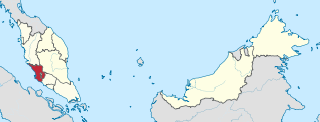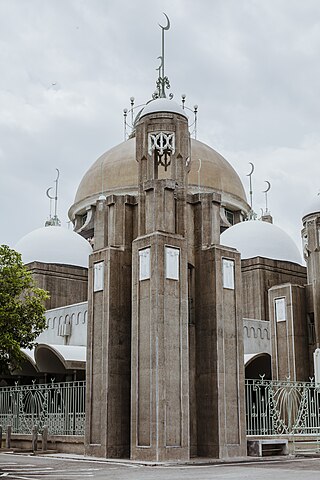
Kuala Lumpur, officially the Federal Territory of Kuala Lumpur, and colloquially referred to as KL, is the capital city and a federal territory of Malaysia. It is the largest city in the country, covering an area of 243 km2 (94 sq mi) with a census population of 2,075,600 as of 2024. Greater Kuala Lumpur, also known as the Klang Valley, is an urban agglomeration of 8.8 million people as of 2024. It is among the fastest growing metropolitan regions in Southeast Asia, both in population and economic development.

Putrajaya, officially the Federal Territory of Putrajaya, is the administrative centre of Malaysia. The seat of the federal government of Malaysia was moved in 1999 from Kuala Lumpur to Putrajaya because of overcrowding and congestion, whilst the seat of the judiciary of Malaysia was later moved to Putrajaya in 2003. Kuala Lumpur remains as Malaysia's national capital city per the constitution and is still the seat of the head of state and the national legislature, as well as being the country's commercial and financial centre.

Shah Alam is a city and the state capital of Selangor, Malaysia and situated within the Petaling District and a small portion of the neighbouring Klang District. Shah Alam replaced Kuala Lumpur as the capital city of the state of Selangor in 1978 due to Kuala Lumpur's incorporation into a Federal Territory in 1974. Shah Alam was the first planned city in Malaysia after independence from Britain in 1957.

Selangor, also known by the Arabic honorific Darul Ehsan, or "Abode of Sincerity", is one of the 13 states of Malaysia. It is on the west coast of Peninsular Malaysia and is bordered by Perak to the north, Pahang to the east, Negeri Sembilan to the south, and the Strait of Malacca to the west. Selangor surrounds the federal territories of Kuala Lumpur and Putrajaya, both of which were previously part of it. Selangor has diverse tropical rainforests and an equatorial climate. The state's mountain ranges belong to the Titiwangsa Mountains, which is part of the Tenasserim Hills that covers southern Myanmar, southern Thailand and Peninsular Malaysia, with Mount Semangkok as the highest point in the state.

Jugra is a mukim, historical town and a former royal town in Kuala Langat District, Selangor, Malaysia. It is separated from Pulau Carey by the Langat River. The town is administered by the Zone 16 of the Kuala Langat Municipal Council.

The Sultan Abdul Samad Building is a late-19th century building located along Jalan Raja in front of Dataran Merdeka and the Royal Selangor Club in Kuala Lumpur, Malaysia. The building originally housed the offices of the British colonial administration, and was known simply as Government Offices in its early years. In 1974, it was renamed after Sultan Abdul Samad, the reigning sultan of Selangor at the time when construction began.

Sultan Sulaiman Royal Mosque is Selangor's royal mosque, which is located in Klang, Selangor, Malaysia. It was constructed by the British in the early 1932 and was officially opened in 1933 by the late Almarhum Sultan Sir Alaeddin Sulaiman Shah.

The Sultan Salahuddin Abdul Aziz Shah Mosque is the state mosque of Selangor, Malaysia. It is located in Shah Alam and is the country's largest mosque and also the second largest mosque in Southeast Asia by capacity. Its most distinguishing feature is its large blue and silver dome. The mosque has four minarets, one erected at each of the corners.

The Ubudiah Mosque is a small mosque located in the royal town of Kuala Kangsar, Perak, Malaysia.

Sultan Sir Abdul Samad ibni Almarhum Raja Bendahara Raja Abdullah was the fourth Sultan of Selangor.

Sultan of Selangor is the title of the constitutional ruler of Selangor, Malaysia who is the head of state and head of the Islamic religion in Selangor. The current monarch, Sultan Sharafuddin Idris Shah ascended the throne on the death of his father, on 22 November 2001.

The Raja Alang Mosque is a historical mosque in Beranang, Sepang District, Selangor, Malaysia. It was named after Raja Alang, who was the son of Tengku Panglima Besar Selangor, Raja Berayun Raja Ibrahim, who ruled Kajang during Almarhum Sultan Sir Abdul Samad's reign. He was from Sumatra, Indonesia.

The Subang Airport Mosque or Masjid Lapangan Terbang Antarabangsa Subang known as Masjid Hijau Subang Airport is a main mosque in Sultan Abdul Aziz Shah Airport in Subang, Selangor, Malaysia. It was built in 1992 and opened on 1994. It is also used as an international mosque for tourists who arrive and depart from Malaysia. When Subang Airport was transferred to Kuala Lumpur International Airport (KLIA) in Sepang on 27 June 1998, it was converted into a public mosque for Muslims from Kampung Subang, Ara Damansara and Saujana.
The architecture of Kuala Lumpur is a blend of old colonial influences, Asian traditions, Malay Islamic inspirations, modern and post modern mix. Being a relatively young city, most of Kuala Lumpur's colonial buildings were built toward the end of 19th and early 20th century. These buildings have Mughal, Tudor, Neo-Gothic or Grecian-Spanish style or architecture. Most of the styling have been modified to cater to use local resources and the acclimatized to the local climate, which is hot and humid all year around.

Sultan Salahuddin Abdul Aziz Shah Al-Haj ibni Almarhum Sultan Hisamuddin Alam Shah Al-Haj was the Sultan of Selangor from 1960, and the eleventh Yang di-Pertuan Agong from 1999, until his death in 2001.

The following lists events from 2014 in Malaysia.

Arthur Benison Hubback was a British Army officer and architect who designed several important buildings in British Malaya, in both Indo-Saracenic architecture and European "Wrenaissance" styles. Major works credited to him include Kuala Lumpur railway station, Ubudiah Mosque, Jamek Mosque, National Textile Museum, Panggung Bandaraya DBKL, Ipoh railway station, and Kowloon railway station.

Jamek Mosque, officially Sultan Abdul Samad Jamek Mosque is one of the oldest mosques in Kuala Lumpur, Malaysia. It is located at the confluence of the Klang and Gombak rivers and may be accessed via Jalan Tun Perak. The mosque was designed by British architect and soldier Arthur Benison Hubback, and built in 1909. It was the principal mosque of Kuala Lumpur until the construction of the national mosque Masjid Negara in 1965.
The following is an alphabetical list of articles related to Selangor.


















